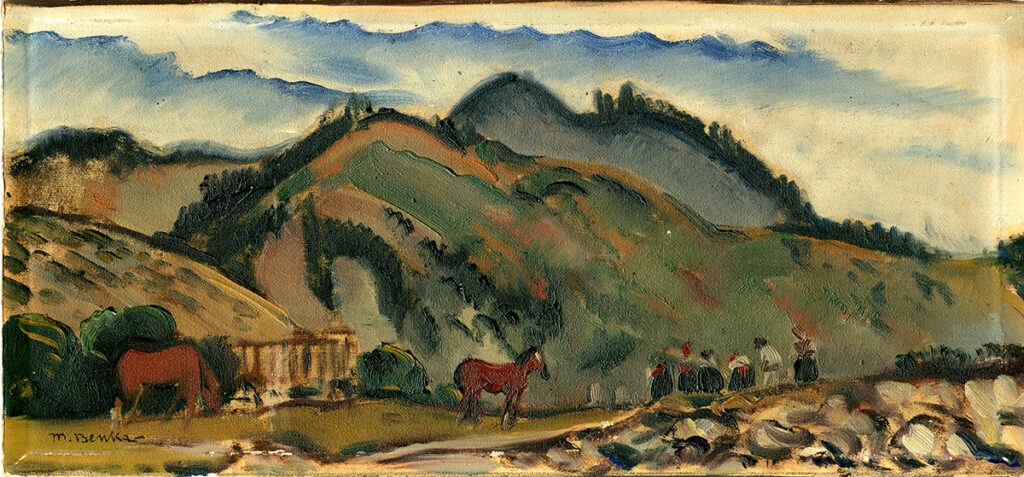The intimate format of the work depicts Benka’s mythologised and idealised mountainous Slovak landscape and its people. In the Field – Orava carries signs of “Benka’s signature plein air painting”. The story the picture tells is presented in suggested stripes. Panoramic romanticising and dominant record of the mountainous landscape of northern Slovakia opens the narrative that takes place in the field. Two unhitched horses, an empty “haywain”, a field track dividing the narrative in two parts. In the front of the right part are probably sacks of potatoes, waiting for more crops or a pickup by the waggon …and there is a group of people further away, probably digging up their (potato) crops (women in black shrouds and pinafores and probably a male figure?). The painting’s earthy colour palette put in contrast with tones of green and blue in the sky create a routine impression of hard work in the fields of the beautiful Orava scenery. The artist heroises simple people and their everyday life’s struggles…
Martin Benka ( 21 September 1881, Kostolište – 28 June 1971, Malacky) is a leading personality and founder of modern Slovak painting. He was a person of many talents – a painter, drawer, typographer, designer, illustrator, scenographer, musician. He began his studies in Hodonín where he learned the trade of (handyman) painting. Later he worked as a journeyman in Vienna. In 1908 he began training at E. Neumann’s studio. Between 1909-1913 he studied at A. Kalivoda’s private panting school in Prague and then began his journeys across northern Slovakia. They were followed by his first studio in Prague, the first solo exhibition (1915). His Slovak debut is dated to 1920 when he was a member of the Slovak Art Society. In 1918 he settled in Prague where he stayed for another twenty years. He studied in various countries like Belgium, France, the Netherlands, Italy, Germany, Morocco… He represented Czechoslovakia atthe Venice Biennale several times. His painting Terchová Landscape received an award in Paris in 1937. In 1939 he moved back to Slovakia and settled in Martin. Between 1940-1941 he led the Department of Drawing and Painting at the Slovak University of Technology in Bratislava. He lived in a studio-equipped house that also had a picture gallery and that was contributed to him by the state. In return, he donated 5000 artworks to the state that laid the foundation for the Martin Benka Museum (a part of the Slovak National Museum). He has a memorial room in his birthplace. His creative work has been awarded many times in Slovakia and abroad. He was a founding member and chairman of the Slovak Art Society. One of the characteristic features of his work are impressive landscapes affected with secession that allowed him to create his own unique style that includes folklore, the picturesqueness of the mountains, idealism and ornamentalism.
He usually composed his paintings into imaginative plans that involved the expression of national identity. Such romanticising ideals are the basis of Benka’s monumental painting. Martin Benka managed to visualise the myth and awareness of the diligence of the Slovak nation.
— Ľudmila Kasaj Poláčková
Bibliography
BAJCUROVÁ, Katarína: Martin Benka. Trenčín : Q-EX, 2005
VÁROSS, Marian: Martin Benka. Bratislava : Tatran, 1981
About Art, 1978
PETRÁNSKY, Ľudovít: Martin Benka. Bratislava : Pallas, 1977
Inventory No. O-1981
Artist: Martin Benka
Title: In the Field – Orava
Year of origin: 20th century, 1st half, 1940-1950
Technique: oil
Material: cardboard
Dimensions: 16 cm × 33,5 cm
Signature: bottom left: M.Benka
